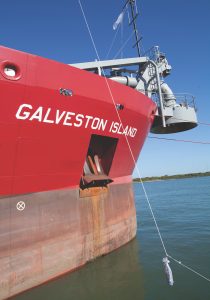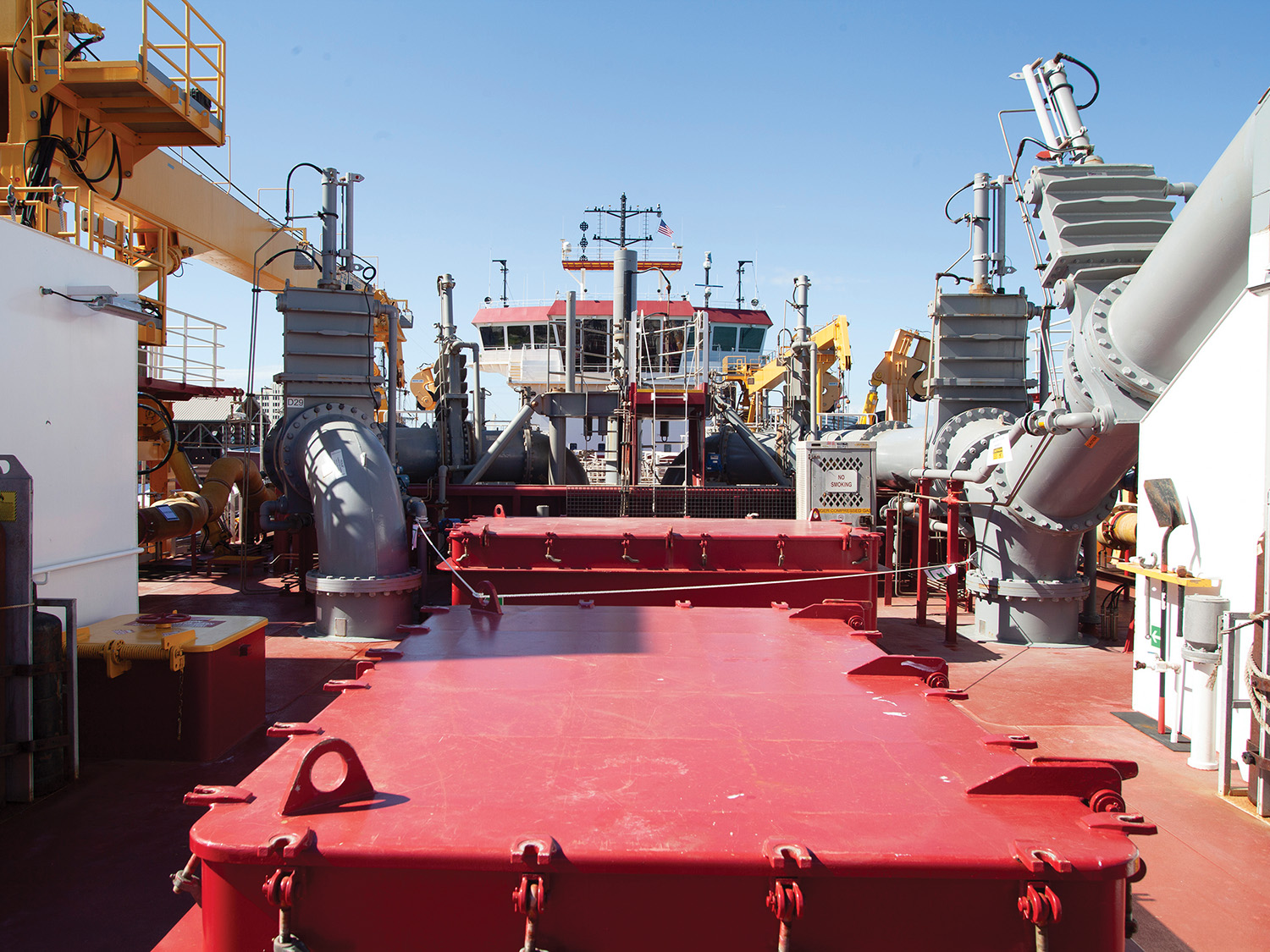Houston-based Great Lakes Dredge & Dock (GLDD) held a naming ceremony and christening October 25 at Pier 21 in Galveston, Texas, for the company’s newest trailing suction hopper dredge, the Galveston Island. The Galveston Island is the first of twin dredges Conrad Industries is building for GLDD at its Morgan City, La., shipyard.
Conrad laid the keel for the Galveston Island in April 2021 and delivered the dredge to Great Lakes in February. The second in the series, to be called the Amelia Island, is due out in 2025.
The Galveston Island has had a busy first eight months since coming online in February.

“Since that time, she’s already worked on five different projects here in the Gulf of Mexico and a couple on the east coast of Florida,” said Chris Gusten, senior vice president of project services and fleet engineering for GLDD, who emceed the naming ceremony. “She’s dredged almost 5 million cubic yards during that time. That’s 20,000 cubic yards per day, every day. Think about that throughput.”
Immediately following the naming ceremony, the Galveston Island headed east to the Sabine-Neches Waterway to complete a deepening project, then on to the Northeast for some coastal restoration work, Gusten said.
“Moving forward, there is a lot of work in her backlog, so she’s going to remain a very busy vessel,” he said.
Designed by C-Job, the Galveston Island has a hopper capacity of 6,500 cubic yards. The dredge measures 346.5 feet long with a 68.5-foot beam. Moulded depth is 23 feet, and the dredge draws 20 feet 5 inches. Max dredging depth of the Galveston Island’s drag arms is 100 feet. Fully loaded, the Galveston Island can achieve 12 knots thanks to its Wabtec Tier 4 main engines that use exhaust gas recirculation rather than selective catalytic reduction, or scrubbers. The dredge does carry a set of Tier 4 generators with scrubbers, but the Galveston Island’s dual-shaft main engines can drive both its propulsion system and its generators. A second set of Wabtec engines powers the Galveston Island’s dredge pumps.
Lasse Petterson, president and CEO of Great Lakes Dredge and Dock, recognized the company’s board of directors, congressional representatives in the audience and members of the U.S. Army Corps of Engineers, “our largest client.” He also introduced his wife, Clara, who broke the bottle of champagne against the hull of the dredge, ceremonially christening the Galveston Island into the GLDD fleet.
“With this addition to our fleet, we’re fulfilling Great Lakes Dredge & Dock’s commitment to invest, modernize and innovate, and to continue to be the largest and most recognized dredging and coastal construction service contractor in the United States,” Petterson said. “The new vessel also represents Great Lakes’ commitment to modernize the industry in support of the Jones Act. The vessel is financed and owned by a U.S. company. It’s built at a U.S. shipyard with U.S. workers and operated by trusted partners from the Seafarers International Union, using U.S. mariners.”
Representing the Corps of Engineers was Andrew Cook, an operations manager with the Galveston Engineer District. Cook and his team oversee the operations and maintenance of the Houston Ship Channel and the Galveston harbor. Cook pointed to the Corps’ mission of maintaining safe navigation in the country’s waterways.
“I can tell you that mission doesn’t happen unless we have this type of equipment behind us,” he said. “With all the work that’s going on within our nation’s ports and across the country, it’s led to an increase in activity for our waterways and an increase in traffic, especially along the Texas coast. With all the deepening and widening projects for our deep draft navigation channels and the continued operations and maintenance of those waterways to keep them clear, I can promise you there is no shortage of dredge material to be moved into the future.”
Attendees also heard from Kelly Teichman, chairman of the board of T&T Marine and chairman of the American Waterways Operators, Joe Zavala with the Seafarers International Union and congressional staffers.
After Clara Petterson swung a bottle against the hull of the dredge, crew members of the Galveston Island led guided tours around the vessel, offering a rare public glimpse of a working dredge.
————
Featured photo caption: A view from the bow toward the stern of the dredge Galveston Island. (Photos by Frank McCormack)




